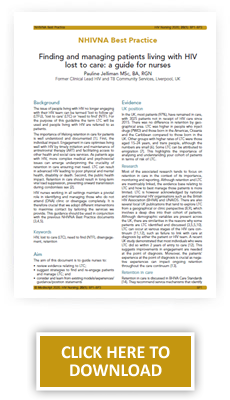Finding and managing patients living with HIV lost to care: a guide for nurses
HIV Nursing 2020; 20(1): BP1–BP3
The aim of this document is to guide nurses to:
review evidence relating to lost to care (LTC);
suggest strategies to find and re-engage patients and manage LTC; and
consider and learn from existing models/experiences/guidance/position statements.
Rules of engagement for ‘hard-to-reach’ patients living with HIV: a guide for nurses
HIV Nursing 2019; 19(4): BP9–BP12
This guidance aims to:
clarify the terms ‘hard to reach’ and ‘patient engagement’ generally and in the context of HIV;
review reasons why there are barriers to engagement between health services and people living with HIV; and
identify components of a best practice model to guide nurses working in HIV, general nurses and other healthcare professionals on how to engage with hard-to-reach individuals and groups.
Barriers to adherence and intentional non-adherence: a guide for nurses
HIV Nursing 2019; 19(3): BP5–BP8
This guidance is aimed at nurses and healthcare professionals who work within the field of HIV, supporting people with HIV who may struggle with adherence or choose to stop taking their ART. The aims of this guidance are:
to identify reasons why people with HIV opt out of ART (intentional non-adherence) or struggle with adherence; and
to identify key components of best practice that will equip nurses to help these people.
The language of HIV: a guide for nurses
HIV Nursing 2019; 19(2): BP1–BP4
Without communication it would be difficult for us to exist and language plays a dominant role in how we communicate. As nurses, verbal and non-verbal communication including language is an essential part of our training. The ability to communicate with patients and colleagues effectively is vital to our work, allowing us to assess, plan and evaluate the care we provide. As we develop and grow into our profession, our language and communication skills expand. Listening to what patients tell and don’t tell us or observing the nuances of body language communicates more than what we are verbally told. Language matters, it has power, it has the power to categorise people in descriptive terms that can be empowering or reductive.
Language impacts how we think about ourselves, and shapes how we see others. Over the past 30 years, people living with HIV have helped shape the language we use and their work has changed the way we discuss death, dying, sex and sexuality; ensuring that new discourse in the HIV field does not stigmatise, but rather catalyses empowerment for community members. Language has shaped person-centred care and, on the whole, people living with HIV have become empowered self-managers informing the delivery of healthcare services.
Download NHIVNA Best Practice - The language of HIV: a guide for nurses

